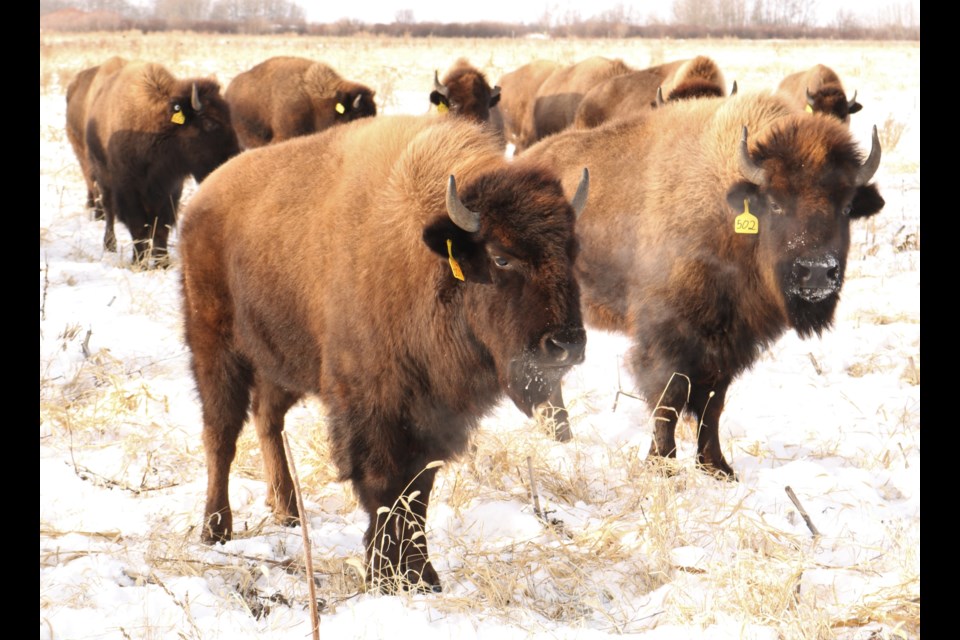Friendly Acres Seed Farm has long been noted as a source of oats in the region.
More recently the long-time seed growing operation south of Saltcoats has evolved; first to an interest in the potential of soybeans as a crop in the region, and most recently to rebuilding soil health through the concept of regenerative agriculture.
But through all the changes the farm has always been a grain farm.
So neighbours may be slowing their vehicles just a little to take a closer look as a herd of bison are now contentedly grazing a well-fenced pasture on the farm operated by Kevin Elmy.
The bison, 77-head which graze a pasture of 320-acres of long term pasture, are not Elmy’s, although for the next several months he is their herdsman.
The animals are in a sense rentals. Elmy is custom-grazing the animals, for Ridgemeadow Bison at Churchbridge.
Elmy said the animals in the small herd are yearling heifers.
“This is future breeding stock,” he explained, adding the owners look for additional pasture so as to rest their own pasture for their stock – which numbers about 800-head, so they seek out other producers with pasture.
For grazing the bison Elmy will be paid based on a fee for growing the heifers.
“I’m paid by the pound of gain,” he said.
They averaged 575 pounds upon arrival.
Elmy said his initial idea was to do some grazing as a way to diversify the farm, and to better utilize the forage crops he has been incorporating into his crop rotation to better the overall soil condition. Of course his first thought was cattle.
Then in a conversation with Randy and Michael Weiss who operate Ridgemeadows they asked “would you consider bison?”
Elmy of course said yes, but he admitted the decision did mean some additional up-front costs for him.
“The costs were a bit more in infrastructure, on fences,” he said, noting where a two-strand fence is generally sufficient for cattle, he opted for a five-strand on the perimetre fence for the bison.
“This is safe, this is good,” he said, but adding the fencing costs were about $25,000.
However, it is an investment that will be functional for years, to the point he suggests they should last 25-years.
In terms of grazing Elmy said the bison “have done a really good job,” of consuming what is available in an area of pasture, then wandering to a new area. He suggested that is because they are still very much the same animal that roamed the Prairies a century, or so, ago.
“Bison are closer to their evolutionary roots,” he said. “We haven’t changed them as much (as we have cattle).”
So bison have bred naturally to graze year-round, not yet used to the idea of a human bringing feed, although Elmy said he does feed screenings from his seed cleaning plant, and if required would haul in hay.
But, as it stands “they’re quite comfortable rooting through the snow looking for grass,” he said.
“They do a better job ... without a lot of day-to-day management.”
Elmy said he has enjoyed spending time in the pasture just watching the noble bison, but a big advantage of the species is they are rather self-sufficient creatures which means he can “spend less time on the farm” in winter months if he needs too.
While there hasn’t been a lot of snow so far this winter, Elmy said he isn’t too worried about how much snow falls, adding he fully expects the bison to graze until April, and perhaps longer “if they have too.”
In addition to the long term pasture Elmy has a quarter section of seeded forage, triticale as a cover crop with perennial rye grasses that he can utilize as silage or pasture as required.
In the future he added, “I might put some grazing corn in there,” adding he did have a patch of corn, and “they cleaned it up well so I would increase my corn acres.”
It is important the bison have a ready supply of feed if he is to achieve a pound of gain per day per animal, the figures he is working with which make the enterprise a good one on the financial side of things.
It also keeps the bison happy so “they want to be here,” meaning they are not eyeing things on the other side of the fence.
The pasture and forage land will become part of the overall crop rotation, over the years being taken out of bison production to grow crops.
That is where bison also play a role. It is important to get the unconsumed plant material back into the soil as part of regenerative farming.
“I’m getting good trampling,” said Elmy.
Although only a few months into what is something of a bison-grazing experiment, Elmy said it has worked out very well, adding when the current herd goes home, and new stock is brought, he could see 120 head roaming his fields.




